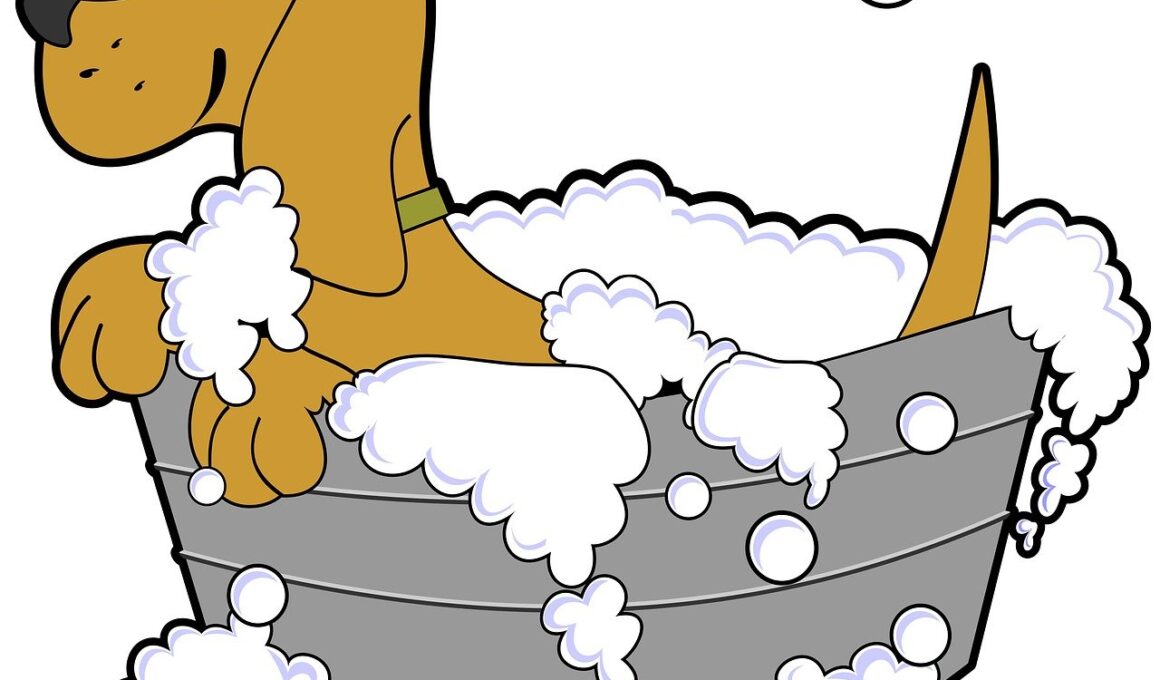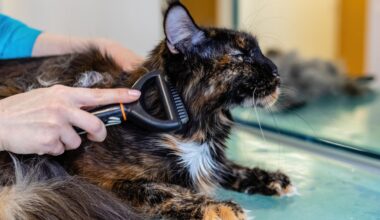Using Grooming Tools Effectively to Combat Dog Parasites
Dog grooming is essential for maintaining your pet’s health and hygiene. Regular grooming helps to detect and prevent parasites like fleas and ticks, which can cause serious health issues. Grooming keeps your dog looking beautiful while ensuring their skin and coat stay healthy. Effective grooming tools include brushes, combs, and scissors. Each tool serves a purpose and contributes to overall parasite management. For instance, a flea comb is specifically designed to catch fleas while being gentle on your dog’s skin. Incorporating grooming into your pet’s routine aids in early parasite detection, preventing infestations. Additionally, brushing helps distribute natural oils in your dog’s coat, promoting a healthy shine. You can choose various grooming tools based on your dog’s coat type and needs. Long-haired breeds may require different tools compared to short-haired breeds. To maximize the effectiveness of grooming, establish a regular grooming schedule. This consistency can make the grooming process more enjoyable for your pet. Remember, a well-groomed dog is not only healthier but also happier!
The Importance of Choosing the Right Tools
Choosing the right grooming tools is critical for managing parasites effectively. Not all tools are suitable for every dog, so understanding your pet’s specific needs is essential. For instance, short-haired dogs may benefit from bristle brushes, while long-haired breeds often require slicker brushes. Selecting the correct type of brush helps ensure a thorough grooming session. Additionally, using a quality flea and tick remover can help eliminate pests efficiently. These removers are designed to work with your dog’s natural grooming routine. When using these tools, ensure they are made from safe materials to avoid skin irritation or allergic reactions. Choosing ergonomically designed tools can also make the grooming experience easier for you. Comfort is essential as you may need to groom your dog frequently to prevent parasites effectively. Furthermore, some grooming tools may include features to remove loose fur and debris. Regularly inspecting your grooming tools for wear and tear is crucial to maintain their effectiveness. A well-maintained grooming kit contributes to a more enjoyable grooming experience for both you and your dog. Remember, proper tools lead to a happier, healthier pet!
Regular brushing is a key component in parasite prevention. It helps remove dirt, debris, and loose fur, making it more difficult for parasites to hide in your dog’s coat. When you establish a routine, pay attention to the areas where parasites are most likely to gather, such as behind the ears, under the legs, and near the tail. Flea and tick infestations often go unnoticed until symptoms develop. Early detection through regular brushing can significantly minimize the risk of a full-blown infestation. Monitor your dog’s skin during grooming sessions for any signs of irritation or parasites. If you find fleas or ticks, it’s imperative to act quickly. Consider using a special shampoo or treatment alongside your grooming routine to treat any infestations. Always follow the instructions provided with these products, as improper use can harm your pet’s skin. In addition, maintaining a clean environment can help prevent new infestations. Regularly vacuum and clean your living area, especially where your dog sleeps. For the most effective parasite control, combine regular grooming with environmental management to keep your furry friend safe.
Grooming Techniques for Effective Results
Utilizing proper grooming techniques is critical for effective parasite control. Start by familiarizing your dog with the grooming process to make it a positive experience. Use gentle strokes and reward your dog for cooperating during grooming. Gradually introduce different tools so your dog can associate them with a pleasant experience. While grooming, focus on areas where parasites frequently hide. Use the flea comb to comb through your dog’s coat thoroughly, paying extra attention to around the ears, belly, and tail. If you notice excessive scratching or irritation, be sure to address those areas specifically. Grooming should be a calming activity, helping your dog feel comfortable and relaxed. Provide breaks and use soothing words to encourage your pet. In addition to using grooming tools, you can integrate baths to remove dirt and parasites. Choose a shampoo specifically formulated to target fleas and ticks, as these can assist in breaking the pest lifecycle. Regular grooming not only aids in parasite prevention but also allows you to strengthen the bond with your furry friend, which is essential for their overall wellbeing.
Using grooming tools effectively extends beyond simply brushing your dog. Different tools can target different issues, making it imperative to have an arsenal of options available. For example, deshedding tools can prevent hair buildup in your home while also removing potential hiding places for parasites. Additionally, you may consider investing in a high-quality grooming glove. These gloves provide a gentler touch, perfect for sensitive dogs who may dislike traditional brushes. Introducing new tools slowly can help your dog adjust to them without fear or anxiety. This gradual introduction encourages your dog to trust you during grooming sessions. Remember also to incorporate nail trimming and dental hygiene into your grooming routine. Nail health can impact mobility, while dental care contributes to overall health. Some tools are dual-purpose, combining grooming and oral care, so be on the lookout for those. Always monitor your dog for reactions to new tools or techniques. A negative experience can deter grooming in the future. Consistency is key; over time, your dog will become more comfortable with the entire grooming process and more resilient against parasites.
Maintaining a Regular Grooming Schedule
Setting a consistent grooming schedule is essential in ensuring your dog remains parasite-free. Regular grooming allows for routine inspections of your dog’s coat for any signs of pests. For most dogs, this means grooming at least once a week. However, active or outdoorsy breeds may require more frequent sessions to keep their coats in prime condition. Establishing a regular schedule allows you to adapt based on your dog’s activity levels, coat type, and climate; the environment might dictate a need for more frequent grooming. Factor in seasonal changes, as certain times of the year see increased flea and tick activity. Maintaining a grooming log can help you keep track of your dog’s grooming needs and any findings during sessions. This information can prove invaluable for identifying patterns related to parasite issues as well as monitoring coat health. Pair your grooming routine with a balanced diet and proper exercise to keep your pet healthy overall. Remember, a well-groomed dog is less likely to become infested with parasites, allowing them to enjoy a happier, healthier life. Building trust and creating positive associations can make grooming a breeze.
Lastly, always stay informed about new grooming trends and products that can assist in parasite control. The pet grooming industry constantly evolves with innovations designed to improve grooming efficiency and effectiveness. Research tools that are specifically known for deterring parasites. Consulting your vet about suitable grooming products can also offer personalized recommendations based on your pet’s unique needs. Additionally, participating in workshops or seminars can provide valuable insights into best practices for grooming and parasite management. Building connections with other dog owners can help you share knowledge and experiences about effective grooming strategies. Online forums and social media groups dedicated to dog care can be excellent resources for tips and advice. Empower yourself by learning more about the different types of parasites, their life cycles, and how they affect pets. Awareness of these factors can enhance your grooming efforts and ensure your dog remains healthy. Remember, the goal of grooming extends beyond aesthetics; it encompasses overall wellness. A proactive approach to grooming and pest control pays off in the long run for both you and your furry friend.
Conclusion
In conclusion, effective dog grooming is a crucial factor in preventing parasites. The use of appropriate tools, techniques, and a regular grooming schedule can significantly reduce the risk of infestations. Always prioritize your dog’s comfort during grooming to anticipate and categorize any signs of discomfort. Routine grooming as part of your pet care can help maintain a healthy coat, promote skin health, and facilitate early detection of potential issues. Investing in high-quality grooming tools is another smart strategy to enhance your grooming experience. Also, don’t forget to integrate preventive measures, such as regular vet visits and environmental cleaning, into your pet care routine. Collaborating this aspect of your dog’s health can ensure optimal results. Lastly, educating yourself about dog grooming and parasite prevention will enhance not only your understanding but also your pet’s wellbeing. Your commitment to grooming contributes significantly to your dog’s overall health and happiness, creating a stronger bond between both of you. In essence, groom regularly, understand your tools, and remember that grooming is as much about love as it is about hygiene.


